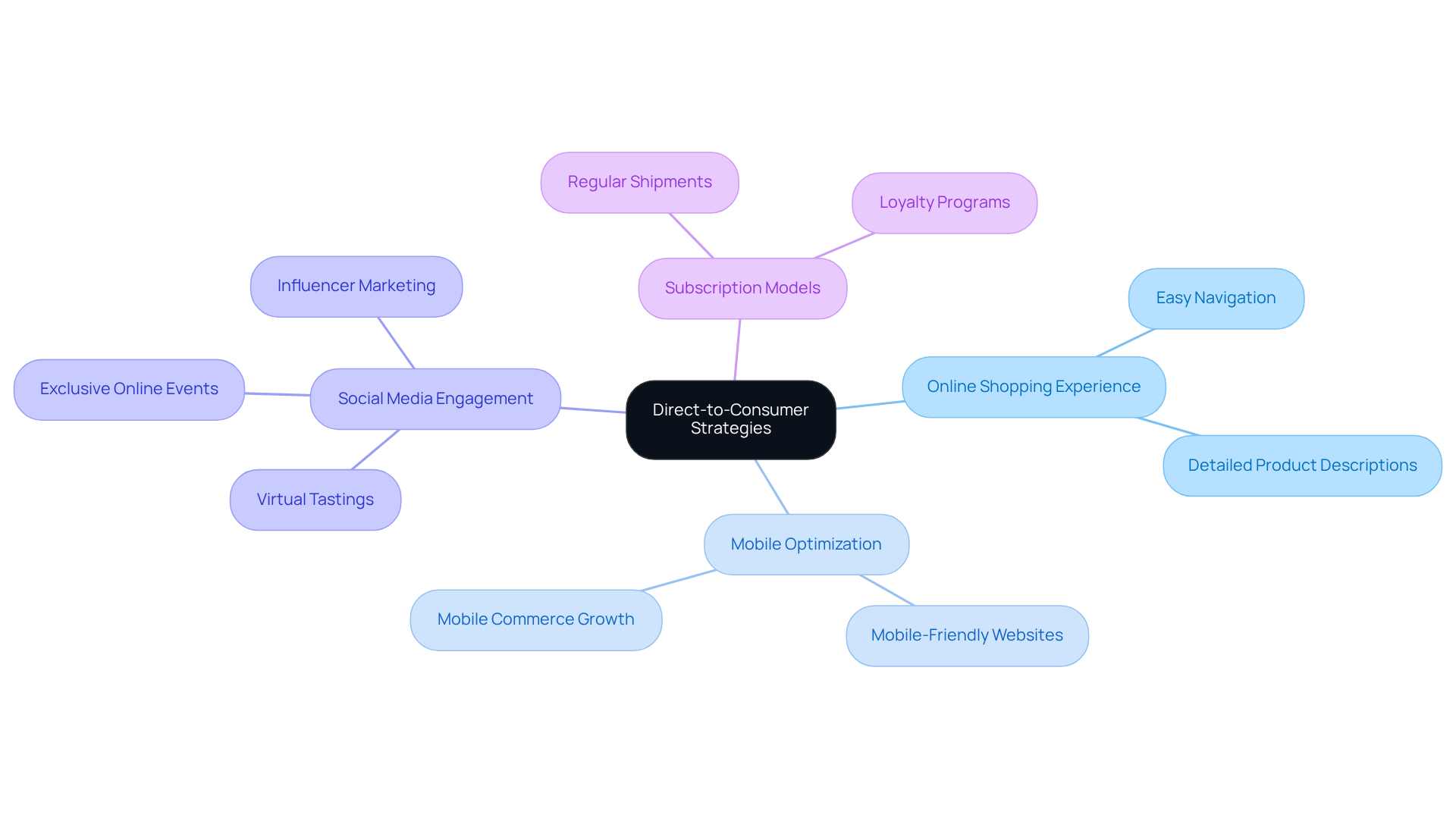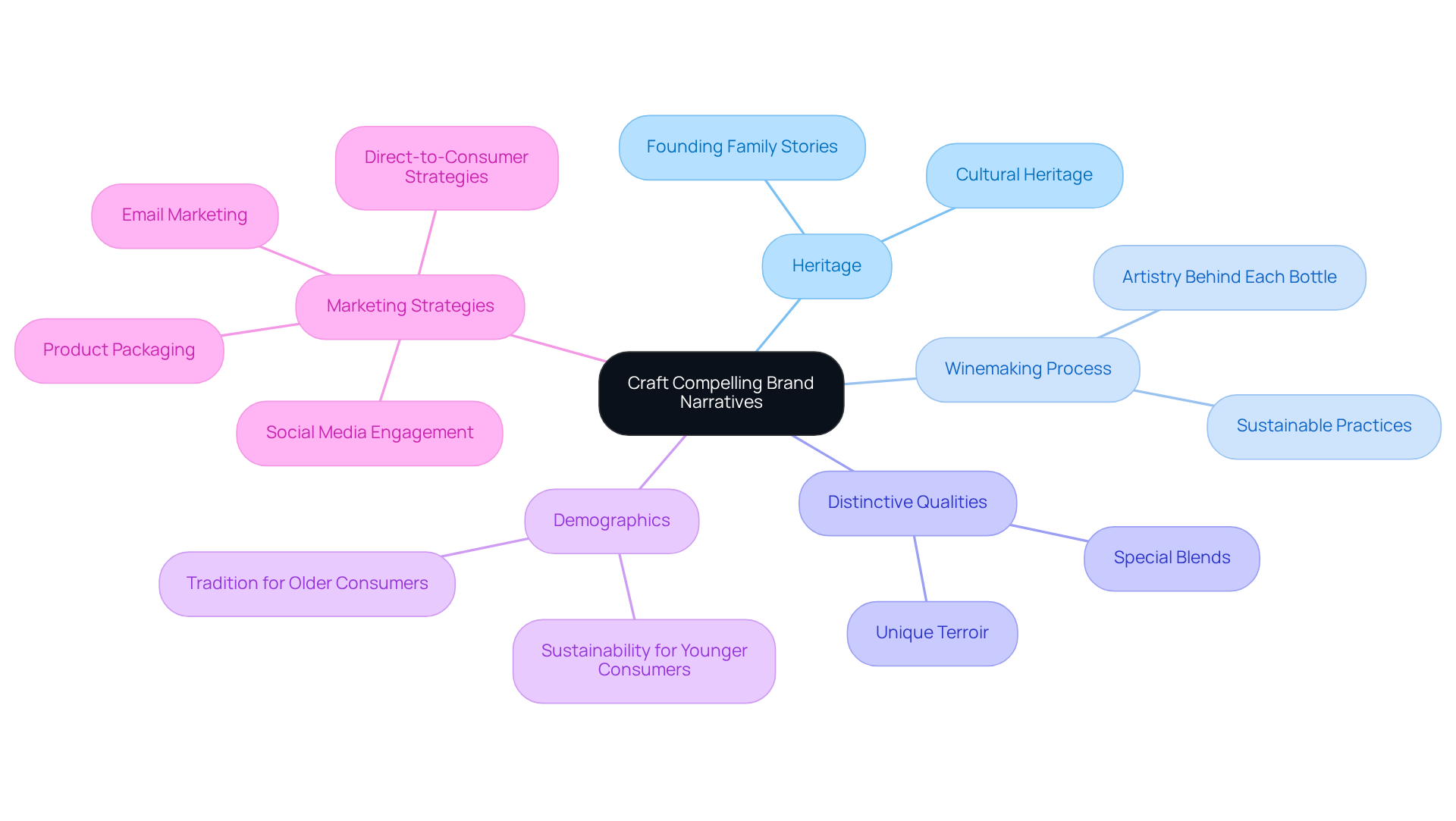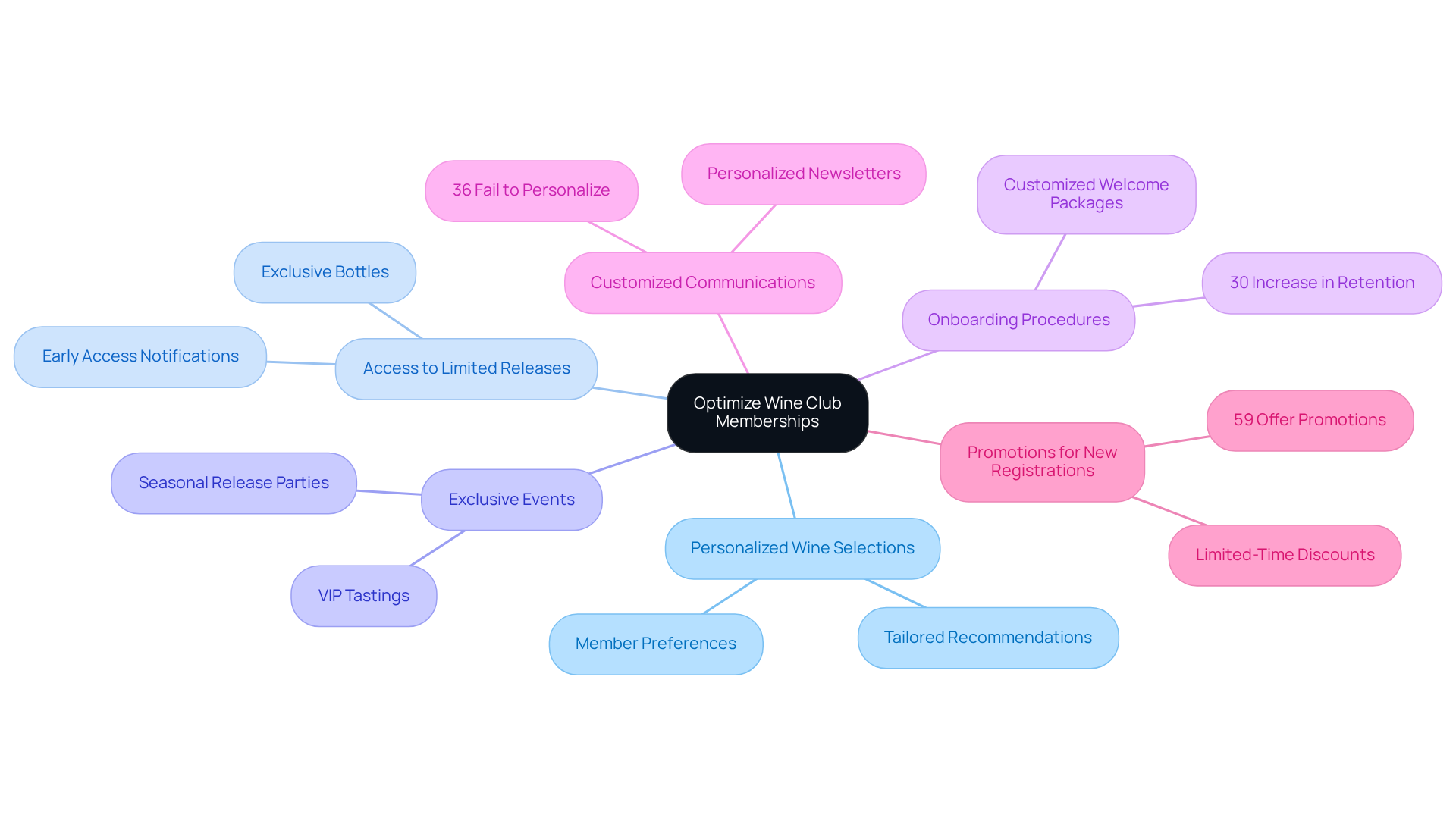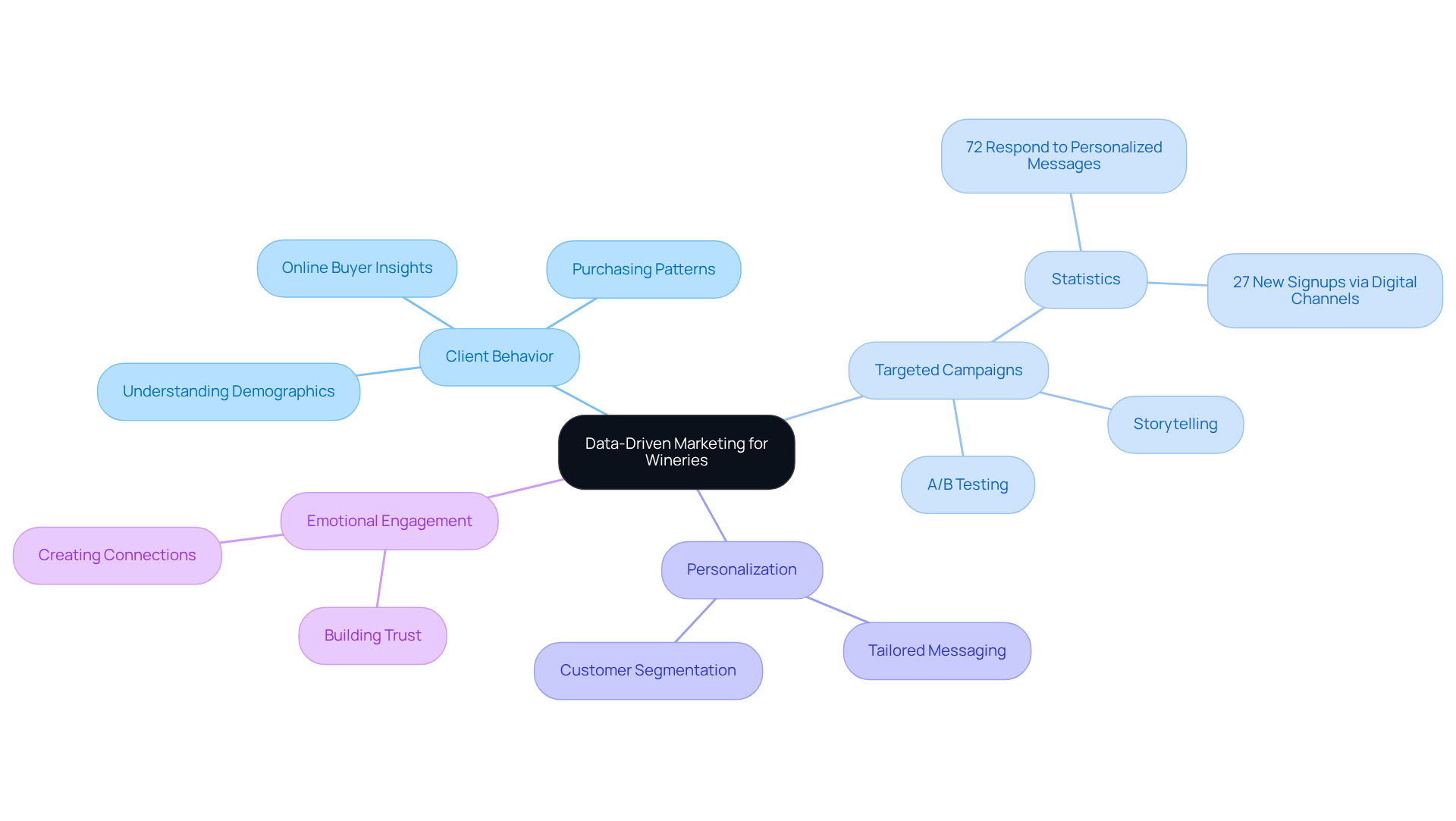Overview
This article presents four proven strategies for achieving advertising success in the wine industry. By focusing on:
- Direct-to-consumer approaches
- Compelling brand narratives
- Optimized wine club memberships
- Data-driven marketing techniques
Wineries can significantly enhance their market presence. Each strategy is backed by evidence illustrating increased customer engagement and sales. A seamless online experience, personalized storytelling, exclusive member benefits, and targeted marketing campaigns are essential elements for wineries seeking to thrive in a competitive landscape.
To capture attention, it is crucial to understand that the wine industry is evolving rapidly, and adapting to these changes is not just beneficial but necessary. The direct-to-consumer model allows wineries to connect with their audience in a more meaningful way, fostering loyalty and repeat business. Compelling brand narratives resonate with consumers, making them feel a part of the winery's story.
Moreover, optimizing wine club memberships can create a sense of exclusivity, offering unique benefits that enhance customer satisfaction. Data-driven marketing techniques enable wineries to tailor their campaigns effectively, ensuring that messages reach the right audience at the right time.
In conclusion, the integration of these strategies not only drives sales but also cultivates a loyal customer base. Wineries that embrace a comprehensive approach to marketing will undoubtedly find themselves at a competitive advantage, ready to meet the challenges of the modern market.
Introduction
The wine industry is undergoing a transformative shift as wineries increasingly adopt innovative advertising strategies to capture consumer attention and drive sales. By harnessing direct-to-consumer approaches, crafting compelling brand narratives, optimizing wine club memberships, and utilizing data-driven marketing, wineries can forge a powerful connection with their audience. However, navigating a saturated market where standing out is essential presents a significant challenge.
How can wineries effectively implement these proven strategies to not only attract but also retain loyal customers in an ever-evolving landscape?
Leverage Direct-to-Consumer Strategies for Effective Advertising
To effectively leverage direct-to-consumer (DTC) strategies, wineries must prioritize the creation of a seamless online shopping experience. Optimizing websites for mobile use is imperative, especially with mobile commerce sales projected to reach $856 billion by 2027. This statistic underscores the necessity of . Easy navigation and detailed product descriptions are essential components that enhance user experience. Furthermore, engaging clients through social media platforms can significantly boost traffic to online shops. For instance, organizing virtual tastings or exclusive online events can generate enthusiasm and promote direct purchases.
Implementing subscription models for regular shipments not only enhances client retention but also ensures stable revenue streams. A notable success story in this realm is a vineyard that achieved an impressive 191% increase in e-commerce sales by adopting a comprehensive DTC strategy, which included personalized marketing and proactive customer engagement initiatives. As industry leaders emphasize, enhancing online shopping experiences is crucial for vineyards striving to succeed in the competitive e-commerce landscape of 2025 and beyond.

Craft Compelling Brand Narratives to Engage Consumers
Wineries must cultivate a narrative that encapsulates their heritage, winemaking process, and the distinctive qualities of their wines. This narrative should be conveyed through diverse channels such as social media, website content, and product packaging. For instance, a vineyard could share the story of its founding family, detailing the challenges they faced and the passion fueling their craft. By incorporating engaging visuals and authentic storytelling, vineyards can create a more compelling narrative that resonates with consumers.
Understanding different demographics and tailoring narratives accordingly is crucial for connecting with a broader audience. Younger consumers may , while older demographics might value tradition. A vineyard that implemented this approach saw a significant increase in customer interaction and sales, as consumers formed a personal bond with the brand. This method not only boosts brand loyalty but also distinguishes vineyards in a saturated market, making storytelling a crucial element of effective marketing plans.
Furthermore, strategic capital planning can aid these efforts by ensuring that vineyards possess the resources required to execute these storytelling approaches effectively. As Enocap emphasizes, "In the wine industry, storytelling isn’t just a buzzword—it’s a tradition."
By utilizing transformative direct-to-consumer strategies, including targeted marketing campaigns and subscription programs, establishments can create sustainable channels that promote consistent growth and convert casual buyers into devoted participants.

Optimize Wine Club Memberships to Boost Customer Loyalty
To enhance wine club subscriptions, producers must focus on offering unique advantages that resonate with their patrons. This includes:
- Personalized wine selections
- Access to limited releases
- Invitations to exclusive events
Additionally, establishing a robust onboarding procedure for new participants can significantly improve their experience and boost retention. For instance, a vineyard that introduced a customized welcome package for new members saw a remarkable 30% increase in retention rates.
It is crucial to recognize that 36% of establishments fail to customize their communications with participants, representing a missed opportunity to foster loyalty among club affiliates. Consistent communication, such as newsletters highlighting upcoming releases and exclusive events, keeps participants engaged and nurtures a sense of community.
Moreover, only 59% of vineyards currently provide promotions for new registrations, indicating that 41% are losing potential opportunities to convert visitors into subscribers. By focusing on these strategies, wine producers can cultivate enduring relationships with their clients and enhance loyalty.
Enocap emphasizes the importance of transforming casual purchasers into dedicated club members through effective strategies, which can significantly support a vineyard's growth. Ultimately, these efforts can lead to a substantial , which rose by 153% during market expansions.

Utilize Data-Driven Marketing to Adapt and Thrive
Wineries must prioritize investment in to effectively monitor client behavior, preferences, and purchasing patterns. This critical information serves as the foundation for developing targeted marketing campaigns, including advertising for wine, that resonate with specific audiences.
For instance, a winery that conducted a comprehensive assessment of its client data uncovered that a significant share of its sales originated from a specific demographic. This insight empowered them to tailor their strategies for advertising for wine, effectively engaging this group and transforming casual buyers into loyal club members.
Furthermore, storytelling enhances audience engagement by forging emotional connections with consumers. Employing A/B testing for email campaigns can reveal which messaging and offers yield optimal results. Notably, 72% of consumers respond positively to marketing messages tailored to their preferences, highlighting the paramount importance of personalization.
Additionally, with 27% of new wine club registrations occurring through online platforms, producers can improve client interaction and foster steady growth by utilizing digital marketing and advertising for wine. By consistently analyzing data and refining their approaches—while also considering the emotional aspects of customer engagement and strategic capital planning—wineries can significantly enhance their marketing ROI and cultivate sustainable growth in an increasingly competitive landscape.

Conclusion
To achieve success in the wine industry, it is essential to implement effective advertising strategies. By focusing on direct-to-consumer approaches, compelling brand narratives, optimized wine club memberships, and data-driven marketing, wineries can establish a robust framework for growth and engagement. These strategies not only enhance the customer experience but also foster lasting relationships with consumers, ultimately leading to increased sales and brand loyalty.
Several key tactics can be adopted by wineries:
- Prioritizing a seamless online shopping experience.
- Engaging storytelling that significantly impacts consumer interactions.
- Optimizing wine club offerings.
- Leveraging data analytics to tailor marketing efforts, ensuring they meet the specific needs and preferences of their audience.
These insights underscore the importance of understanding consumer behavior and adapting strategies accordingly.
In a competitive market, the significance of these advertising strategies cannot be overstated. Wineries that embrace these methods will not only stand out but also cultivate a loyal customer base that appreciates the unique narratives and experiences they offer. By investing in these proven techniques, wineries can thrive and ensure their success in the evolving landscape of wine marketing.
Frequently Asked Questions
What is the main focus of direct-to-consumer (DTC) strategies for wineries?
The main focus of DTC strategies for wineries is to create a seamless online shopping experience for customers.
Why is mobile optimization important for wineries?
Mobile optimization is important because mobile commerce sales are projected to reach $856 billion by 2027, highlighting the need to cater to mobile users.
What are key components that enhance user experience on winery websites?
Key components that enhance user experience include easy navigation and detailed product descriptions.
How can wineries engage clients through social media?
Wineries can engage clients through social media by organizing virtual tastings or exclusive online events to generate enthusiasm and promote direct purchases.
What is the benefit of implementing subscription models for wineries?
Implementing subscription models enhances client retention and ensures stable revenue streams.
Can you provide an example of a successful DTC strategy in the wine industry?
A notable success story is a vineyard that achieved a 191% increase in e-commerce sales by adopting a comprehensive DTC strategy, which included personalized marketing and proactive customer engagement initiatives.
Why is enhancing online shopping experiences crucial for vineyards?
Enhancing online shopping experiences is crucial for vineyards to succeed in the competitive e-commerce landscape of 2025 and beyond.




